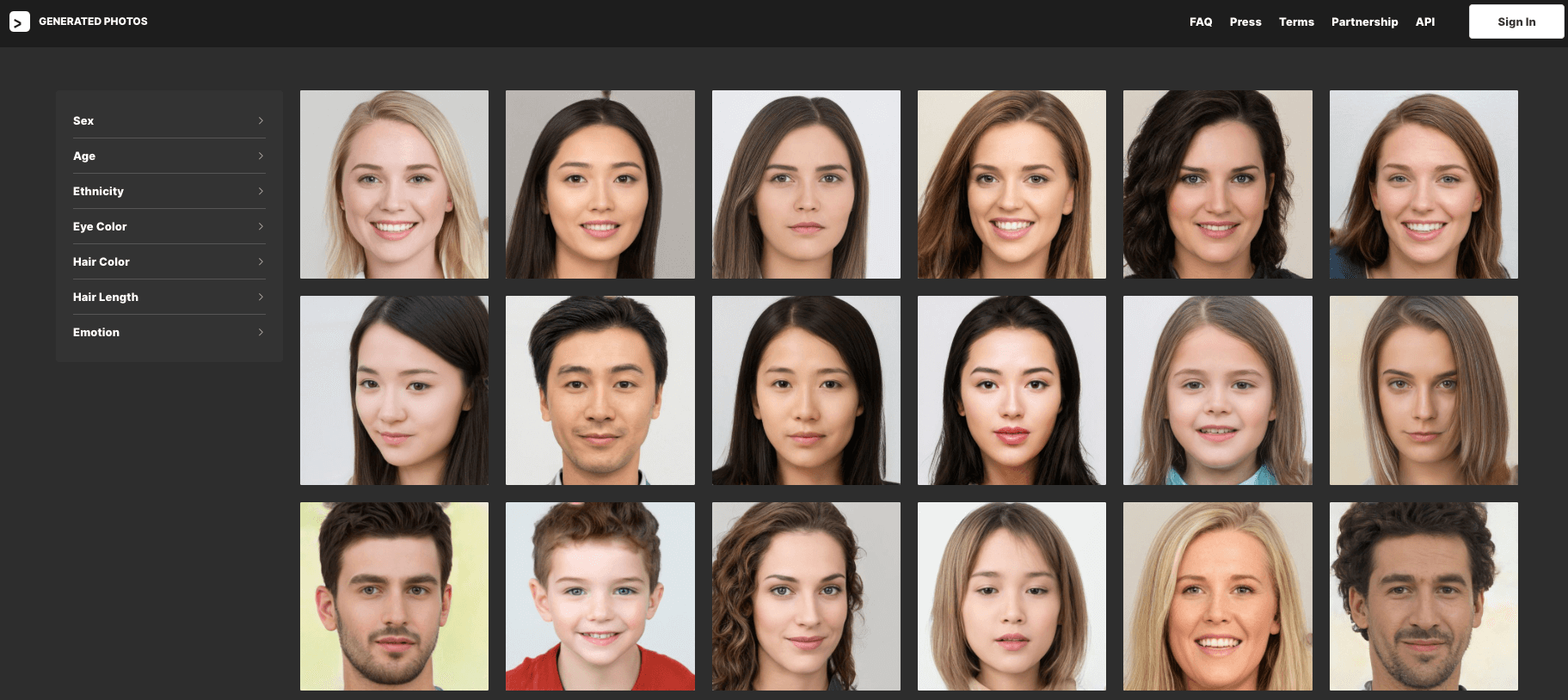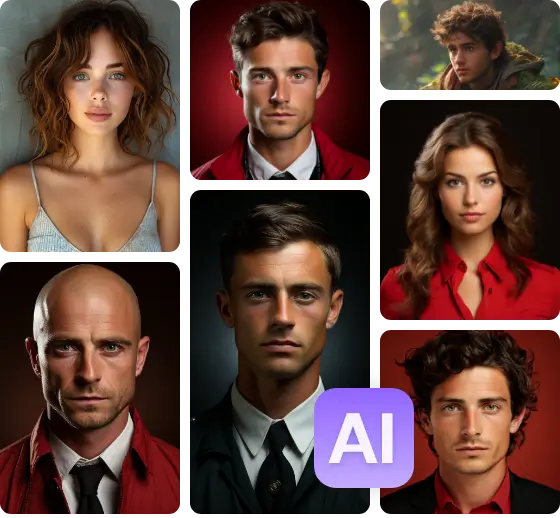The creation and perception of artificially generated faces fascinate both technologists and psychologists. As artificial intelligence advances, the technology behind generating realistic human faces has become increasingly sophisticated. These synthetic images often evoke reactions similar to those elicited by real human faces, engaging areas of the brain responsible for processing emotions, intentions, and social cues.
This connection stems from our inherent ability to read and respond to facial expressions, a skill deeply embedded in human evolution and social interaction. This understanding is crucial for developers creating virtual avatars and AI models, ensuring these entities appear believable and elicit the intended emotional responses from human users. The study of this subject offers insights into the future of human-computer interaction and the ethical implications of digital human representation.

Generated Faces: A Technical Marvel
Picture a world where one can create faces that seem as real as our neighbors’. This is not science fiction; it’s the magic of tech. This art of crafting lifelike faces through machines amazes us all. Faces that did not exist now smile back at us, thanks to clever designers and smart algorithms. This is the realm of generated faces. Let’s dive into the science and AI that make this possible.
The Science Of Creating Artificial Faces
- Biometrics: AI studies our facial details, like eyes and smiles.
- Algorithms: They mix features to craft new faces.
- Data: AI needs lots of face photos to learn from.
Creating faces is like baking a cake. Just as you need the right ingredients and recipe, AI needs good data and rules. It’s all about patterns. AI learns what makes a face look real and then creates new ones from scratch.
How Ai Is Reshaping Facial Generation
- Speed: AI can make faces faster than any artist could.
- Variety: No two AI-generated faces are the same.
- Accuracy: These faces can trick even sharp eyes.
AI facial generation is a game-changer. It’s not only about making new faces, but making them well. Movies, games, and even security use AI faces. Each face is unique and detailed, making them fit for any screen or scenario.
What started as a tech experiment has now blossomed into a field filled with endless creative potential. The journey from pixel to person has never been so intriguing.

Cognitive Responses To Synthetic Beings
Cognitive responses to synthetic beings stir up intriguing discussions in the realm of human-computer interaction. As technology forges ahead, creating more lifelike avatars and generated faces, understanding how our brains react to these synthetic entities becomes increasingly vital. What are these responses, and how do they affect our interaction with our artificial counterparts? These questions lie at the heart of current research and debate.
Human Perception Of Artificial Faces
Our ability to recognize and process faces is deeply rooted within our neural pathways. Artificial faces, though similar to human ones, can trigger distinct cognitive reactions. The Uncanny Valley theory suggests that as a face becomes more realistic, but not perfectly human, our sense of familiarity drops, creating discomfort or even revulsion. It is essential to consider how these perceptions can shape our responses and expectations in a world where digital interactions are a norm.
- Identifying Emotions: Humans are adept at reading emotions on their natural faces. This skill can falter with synthetics.
- Trust and Interaction: Trust may wane when we interact with artificial entities, which impacts social rapport.
- Mimicry Limitations: Synthetic beings might miss subtle cues, leading to a breakdown in nonverbal communication.
Psychological Effects Of Hyper-realistic Avatars
Hyper-realistic avatars are at the peak of digital ingenuity. Yet, they bring forth pronounced psychological implications. When avatars replicate human likeness with precision, our brains may struggle to discern reality from simulation. This cognitive dissonance can evoke a mix of wonder and unease. Affected areas include:
| Area of Impact | Effect |
| Social Connection | The presence of hyper-realistic avatars can either enhance or impede the sense of genuine social interaction. |
| Identity Perception | Avatars that closely mimic themselves or others can blur the lines between one’s digital and actual selves, affecting personal identity. |
| Moral Considerations | With realistic avatars, ethical concerns arise, especially those related to deception and the authenticity of experiences. |
Understanding the deep psychological effects of interacting with near-perfect digital representations is crucial for future developments in technology. It shapes the evolution of digital communication, ethics, and even mental health practices concerning our interactions with synthetic beings.
The Uncanny Valley Phenomenon
Exploring generated faces unlocks a fascinating branch of psychology: the Uncanny Valley phenomenon. This occurs when artificial faces appear nearly human, but a subtle eeriness persists. Understanding this psychological occurrence reveals the fine line between comfort and discomfort in human perception of artificial entities like robots or computer-generated characters.
Origins And Implications Of The Uncanny Valley
The term Uncanny Valley sprang from the intuitive work of robotics professor Masahiro Mori in 1970. His theory suggests that as robots become more human-like, our feelings towards them grow fonder. Yet, there’s a sharp drop in comfort level once they closely resemble humans but are not quite perfect. Here, they fall into the ‘valley’ of unease.
This drop raises intriguing implications:
- Design challenges in robotics and animation
- Potential impact on social interactions
- Questions about empathy towards non-human entities
Evolving design practices now aim to circumvent this valley or make the leap across it.
Bridging The Gap Between Artificial And Human-like
How do we cross the valley? Scientists and designers are finding innovative ways. They focus on creating artificial beings that are either less eerie or indistinguishable from humans.
Key strategies involve:
- Perfecting facial expressionsand movements
- Enhancing emotional responsiveness
- Ensuring consistentdetails
These strategies seek to merge the artificial and the authentic seamlessly. Utilizing advanced technologies and psychological insights, we’re inching closer to closing the uncanny gap. The goal is clear: create faces that resonate with our innate human perception, avoiding the eerie valley altogether.

Trust And Empathy Toward Virtual Faces
Imagine meeting someone without ever seeing their true face. Yet with trust and empathy, real connections form. Virtual faces, though computer-generated, can evoke real human emotions. Understanding why and how we connect with these faces is fascinating. The journey of trust begins with a look, a smile, or a nod, even if it’s from a screen.
Building Rapport With Generated Personas
First impressions matter, even in the digital world. Generated faces need to convey warmth and reliability to earn trust. This isn’t just about beauty or perfection; it’s about relatability.
- Consistencyin facial expressions builds recognition.
- Small talk through chatbots enhances bonds, just like humans.
The key to rapport with these personas depends on their perceived thoughtfulness. Details, like remembering past interactions, matter. These seemingly small touches spark a genuine sense of camaraderie.
The Influence Of Virtual Faces On Social Interaction
Virtual faces are more than digital masks; they’re social catalysts. They bridge gaps in remote communication, making distant interactions feel close and personal.
- Animated facial cues on avatars lead to dynamic conversations.
- Emojis or virtual reactions during text chats emulate human emotions.
The influence of virtual faces is profound. With every nod and smile, they draw people into engaging exchanges, enriching the social fabric of the digital world.
Ethical Considerations In Facial Generation
The creation of synthetic faces presents various ethical issues that merit attention. From influencing human perception to stirring ethical debates, facial generation technology wields power that comes with significant responsibilities. Topics such as privacy rights and digital impersonation are at the forefront of these ethical discussions. We must examine these implications closely.
Privacy Concerns With Face Synthesis
Face synthesis technologies can create realistic images of people who don’t exist. This raises significant privacy concerns:
- Identity Misuse:Generated faces could be mistaken for real individuals, leading to identity confusion.
- Data Security:The data used to create these faces might be sourced without consent, compromising privacy.
- Unintended Use:Synthesized images might be used in misleading or harmful ways, affecting real people’s lives.
Moral Dilemmas Of Digital Impersonation
The act of digitally impersonating someone presents its own set of moral challenges:
- Consent:Is it right to mimic someone’s appearance without their permission?
- Intent:What are the intentions behind creating a digital double, and are they ethical?
- Accountability:Who is responsible when a generated face is used for deceit?
The Future Of Face Generation
The digital world is rapidly evolving and the field of face generation takes giant strides into the future. High-quality, realistic faces crafted by artificial intelligence are becoming the norm. This opens a myriad of possibilities across different sectors.
Advancements On The Horizon For Face Generation
Significant progress in AI and machine learning hints at a future where generated faces are indistinguishable from real ones. Here’s what’s coming:
- Higher Resolution Images
- More Diverse Features
- Improved Age and Gender Accuracy
- Faster Generation Speeds
Face synthesis with incredible detail is around the corner. Ethical AI algorithms ensure this technology benefits society responsibly.
Potential Societal Impacts Of Evolving Ai Technology
As face generation technology matures, its effects will be widely felt. Here are some anticipated impacts:
| Area of Impact | Potential Effect |
| Security | Enhanced surveillance and personal verification systems |
| Entertainment | Realistic characters in games and movies |
| Identity Privacy | New challenges in protecting individual’s likeness |
| Social Media | Custom avatars for user profiles |
Overall, generated faces will redefine animation, entertainment, and security. This technology must align with ethical standards to prevent misuse.
Frequently Asked Questions Of The Psychology Behind Generated Faces: Understanding Human Perception
What Is Face Perception Psychology?
Face perception psychology studies how the brain recognizes and interprets human faces, including emotions, identity, and social information. This field explores the cognitive processes behind facial recognition and the psychological significance of facial cues.
What Is The Psychology Of Facial Recognition?
The psychology of facial recognition involves understanding how the brain processes and identifies human faces. It studies the cognitive mechanisms enabling us to recognize and differentiate between individual faces, often instantaneously, and how emotional responses tie into recognition.
What Is The Philosophy Of Face Perception?
The philosophy of face perception explores how we recognize and interpret human faces. It examines the cognitive processes behind facial recognition and social communication, considering the innate and learned aspects of identifying facial features and expressions.
How Does The Human Brain Recognize Faces?
The human brain recognizes faces using the fusiform gyrus, which activates the specialized neural network for facial features and expressions. This process allows for quick and accurate identification.
Conclusion
Unlocking the secrets of artificial portraiture enhances our grasp of perception. It challenges us to discern realities from digital constructs. As technology shapes our visual landscape, we become adept at navigating this new reality. Embrace the exploration of these virtual visages—they redefine human connection and understanding in the digital age.
